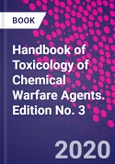Handbook of Toxicology of Chemical Warfare Agents, Third Edition, covers every aspect of deadly toxic chemicals used in conflicts, warfare and terrorism. Including findings from experimental as well as clinical studies, this essential reference offers in-depth coverage of individual toxicants, target organ toxicity, major incidents, toxic effects in humans, animals and wildlife, biosensors and biomarkers, on-site and laboratory analytical methods, decontamination and detoxification procedures, and countermeasures.
Expanding on the second edition, Handbook of Toxicology of Chemical Warfare Agents has been completely updated, presenting the most recent advances in field. Brand new chapters include a new chapter on emergency preparedness, coverage of the chemical warfare agents used in Syria, the use of the Novichok agent in the UK, and more.
Table of Contents
Section I: Historical Perspective and Epidemiology 1. History of Toxicology: From Killers to Healers; 2. Historical Perspective of Chemical Warfare Agents; 3. Global Impact of Chemical Warfare Agents Used Before and After 1945; 4. Sarin Attacks in Japan: Acute and Delayed Health Effects in Survivors; 5. Early and Delayed Effects of Sulfur Mustard in Iranian Veterans After the Iraq-Iran Conflict; 6. Epidemiology of Chemical Warfare Agents; 7. Chemical Weapons of Mass Destruction and Terrorism: A Threat Analysis
Section II: Agents That Can Be Used as Weapons of Mass Destruction 8. Organophosphate Nerve Agents; 9. Russian VX; 10. Novichoks; 11. Blister Agents; 12. Riot Control Agents; 13. Phosgene oxime; 14. Psychotomimetic Agent BZ (3-Quinuclidinyl Benzilate); 15. Fluoroacetate; 16. Strychnine; 17. Superwarfarins; 18. PCBs, Dioxins and Furans: Human Exposure and Health Effects; 19. Polycyclic Aromatic Hydrocarbons: Implications for Developmental, Molecular, and Behavioral Neurotoxicity; 20. Thallium; 21. Arsenicals: Toxicity, Their Use as Chemical Warfare Agents, and Possible Remedial Measures; 22. Chlorine; 23. Phosgene; 24. Carbon Monoxide: Can't See, Can't Smell, Body Looks Red But They Are Dead; 25. Acute Cyanide Toxicity and its Treatment: The Body is Dead and Maybe Red but Does Not Stay Red for Long; 26. Methyl Isocyanate: The Bhopal Gas; 27. Other Toxic Chemicals as Potential Chemical Warfare Agents; 28. Ricin; 29. Botulinum Toxin; 30. Onchidal and Fasciculins; 31. Cyanobacterial (Blue-Green Algae) Toxins
Section III: Target Organ Toxicity 32. Chemical Warfare Agents and the Nervous System; 33. Behavioral Toxicity of Nerve Agents; 34. The Respiratory Toxicity of Chemical Warfare Agents; 35. Cardiovascular System as a Target of Chemical Warfare Agents; 36. Ocular Toxicity of Chemical Warfare Agents; 37. Skeletal Muscle; 38. Dermal Toxicity of Sulfur Mustard; 39. Reproductive Toxicity and Endocrine Disruption of Potential Chemical Warfare Agents; 40. Liver Toxicity of Chemical Warfare Agents; 41. Renal System; 42. Impact of Chemical Warfare Agents on the Immune System
Section IV: Special Topics 43. Health Effects of Nuclear Weapons and Releases of Radioactive Materials; 44. Clinical and Cellular Aspects of Traumatic Brain Injury; 45. Neurological Effects and Mechanisms of Blast Overpressure Injury; 46. Genomics and Proteomics in Brain Complexity in Relation to Chemically-Induced PTSD; 47. Excitotoxicity, Oxidative Stress, and Neuronal Injury; 48. Blood-Brain Barrier Damage and Dysfunction by Chemical Toxicity; 49. The Effects of Organophosphates in the Early Stages of Human Skeletal Muscle Regeneration; 50. Experimental modeling for delayed effects of organophosphates; 51. Alternative Animal Toxicity Testing of Chemical Warfare Agents
Section V: Toxicokinetics, Toxicodynamics and Physiologically-Based Pharmacokinetics 52. Toxicokinetic Aspects of Nerve Agents and Vesicants; 53. Toxicokinetics and Toxicodynamics of DFP; 54. Physiologically Based Pharmacokinetic Modeling of Chemical Warfare Agents; 55. Biotransformation of Warfare Nerve Agents
Section VI: Analytical Methods, Biosensors and Biomarkers 56. Laboratory Analysis of Chemical Warfare Agents, Adducts, and Metabolites in Biomedical Samples; 57. On-Site Detection of Chemical Warfare Agents; 58. Neuropathy Target Esterase as a Biomarker and Biosensor of Delayed Neuropathic Agents; 59. The crosslinking action of organophosphorus poisons; implications for chronic neurotoxicity; 60. Monitoring of Blood Cholinesterase Activity in Workers Exposed to Nerve Agents
Section VII: Risks to Animals and Wildlife 61. Potential Agents That Can Cause Contamination of Animal Feed stuff and Terror; 62. Chemical Warfare Agents and Risks to Animal Health; 63. Threats to Wildlife by Chemical and Warfare Agents
Section VIII: Emergency Preparedness, Prophylactic, Therapeutic and Countermeasures 64. Pharmacological Prophylaxis Against Nerve Agent Poisoning: Experimental Studies and Practical Implications; 65. Prophylactic and Therapeutic Measures in Nerve Agents Poisoning; 66. Physiologically Based Pharmacokinetic/Pharmacodynamic Modeling of Countermeasures to Nerve Agents; 67. Research on Medical Countermeasures for Chemical Attacks on Civilians; 68. Pyridinium Oximes in the Treatment of Poisoning with Organophosphorus Compounds; 69. Novel Cholinesterase Reactivators; 70. Paraoxonase (PON1), detoxication of nerve agents, and modulation of their toxicity; 71. The role of carboxylesterases in therapeutic interventions of nerve agent poisoning; 72. Catalytic bioscavengers: the new generation of bioscavenger-based medical countermeasures
Section IX: Decontamination and Detoxification 73. Rapid Decontamination of Chemical Warfare Agents from the Skin








